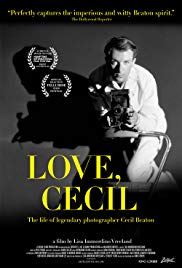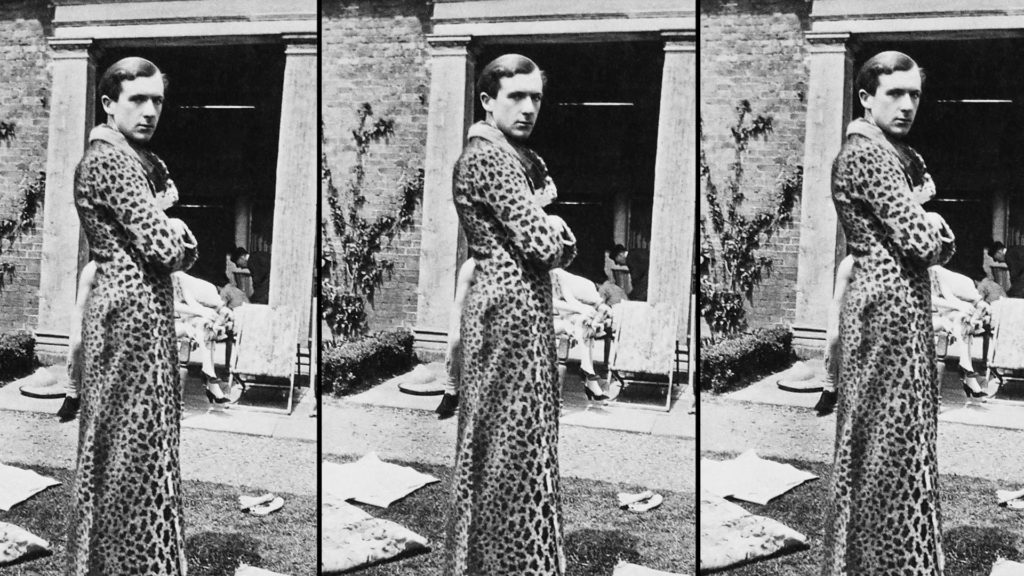by Glenn Dunks
 Cecil Beaton was a dandy. He was an elegant fop, an aesthete, a bright young thing, a (mostly) homosexual. These are all words used to describe him in Love, Cecil, a charming bio-doc from director Lisa Immordino Vreeland. They are words not used in malice, but in reverence to a man whose singular attitudes flew in the face of what men were ‘supposed’ to be. Cecil Beaton had about him an air of posh aristocracy that belied his place in society, but which would ultimately allow him to become ingratiated into the inner-sanctum of Britain’s upper-class (including right up the Queen herself), the world of celebrity, and even the Academy as the Oscar-winning designer behind Gigi and My Fair Lady. He also just happens to be one of the great photographers of the 21st century
Cecil Beaton was a dandy. He was an elegant fop, an aesthete, a bright young thing, a (mostly) homosexual. These are all words used to describe him in Love, Cecil, a charming bio-doc from director Lisa Immordino Vreeland. They are words not used in malice, but in reverence to a man whose singular attitudes flew in the face of what men were ‘supposed’ to be. Cecil Beaton had about him an air of posh aristocracy that belied his place in society, but which would ultimately allow him to become ingratiated into the inner-sanctum of Britain’s upper-class (including right up the Queen herself), the world of celebrity, and even the Academy as the Oscar-winning designer behind Gigi and My Fair Lady. He also just happens to be one of the great photographers of the 21st century
Love, Cecil is Vreeland’s most accomplished film to date...
I was a fan of Diana Vreeland: The Eye Has to Travel, the 2011 documentary about the director’s great-grandmother-in-law, but less taken by her follow-up, the disappointing Peggy Guggenheim: Art Addict. Where I felt that latter film shunted the glorious art in favor of the lavish life of its far less interesting heiress subject, Love, Cecil pushes Beaton’s art to the forefront. The camera scans across graphic tableaus of his photography, accentuating and highlighting the details that he was so well known for. There is simply so much work on display here, from his early portraiture, the revolutionary Vogue work, his efforts as a war photographer in WWII, his rise as the capturer of celebrities, and his re-emergence into Hollywood film production.

Blessedly, the photos rarely zip by as they so often can in films about photographers, eager as they always are to include as much as possible. Despite the sheer number of imagery shown, Vreeland and her editor Bernadine Colish allow the works to linger just long enough with a soft pan or a gentle zoom. Color is incorporated to embellish when necessary, and the frame is almost always occupied, never allowing a single photograph to sit by itself when there is so much space left on the screen.
Like the man himself, Love, Cecil has an elegant ease to it. Story sidebars, cutaways and narrative divergences are incorporated with a natural air. It is a film surprisingly unencumbered by awkward segues or lengthy dalliances of unnecessary directorial flare. Vreeland is wise to keep her film briskly paced and light as air. Alongside Beaton’s own voice in archival interviews, Rupert Everett appropriately provides narration from Beaton’s diaries, an ingenious match made in heaven (perhaps even more so than Everett as Oscar Wilde in the upcoming The Happy Prince, although I yet to see that).
The one area I wish the film had dived a little bit deeper into was the homoeroticism of Cecil’s WWII photography? Not just because I personally think it’s interesting (I do), but because it is something so rarely discussed within the context of war and it was something that Beaton was clearly in retrospect attempting to highlight in a career that had until that stage been significantly focused on the less erotic faces, limbs and fashions of his female clients that rarely permitted such overt exaggeration of his sexuality to surface. Although, to be perfectly, there is an entire documentary to be made about that subject so hopefully somebody with a keenly queer eye can pick up that baton and examine it more broadly than just Cecil Beaton.

I was quite taken by Love, Cecil. It is a biographic tribute through and through and yet avoids outright hagiography. It luxuriates in his work while allowing us the opportunity to learn why his art works and how they functioned and does so without letting the film succumb to the dryness of a history lecture. It’s obvious that there is much more of Cecil Beaton’s life to engage with – the film itself repeatedly acknowledges that Beaton published book after book of photographs, sketches, diaries and correspondents. But what’s here is an often dazzling display of this man’s life-work, presented adoringly and with true affection as one would expect and that offers this Edwardian dandy the sort of dreamy celebration that will open the eyes of many for whom Cecil Beaton was an unknown.
Release: Out now in NYC through Zeitgeist Films, expanding across the country throughout July and August.
Oscar Chances: Unlikely, although Finding Vivian Meier found favor so perhaps there are some photography nuts in there that could send it further than I suspect. Otherwise it's perhaps a bit too light for the branch.